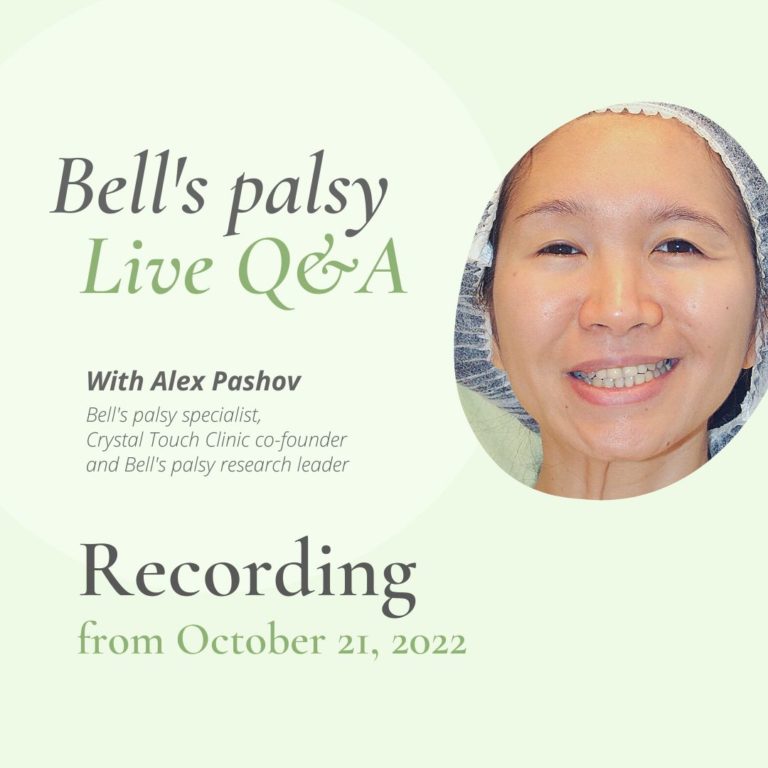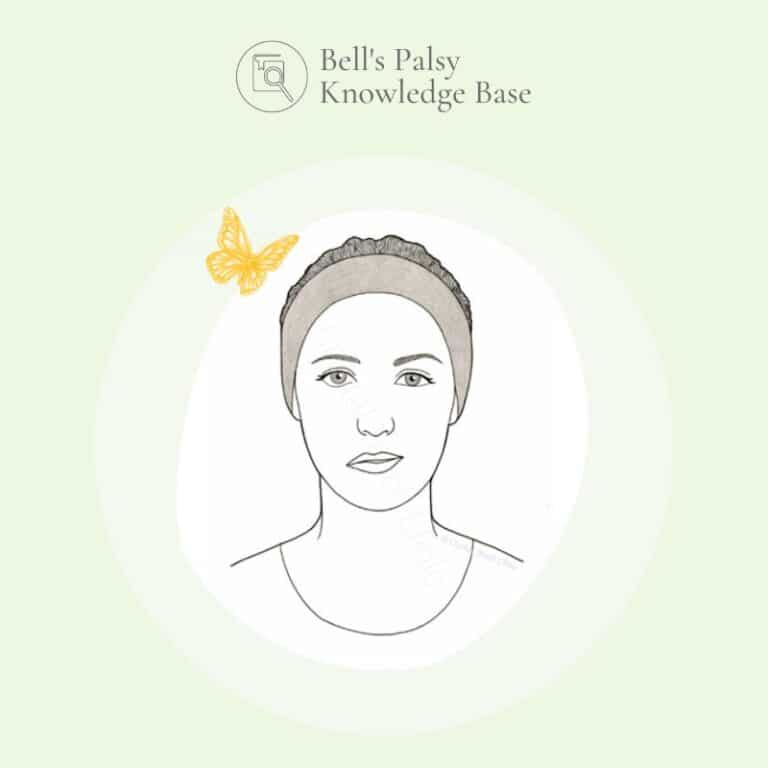At Crystal Touch, we have been working with Bell’s palsy patients from around the world for over 10 years. All these years have taught us what works and what does not work when it comes to Bell’s palsy and synkinesis recovery. We are happy to share our knowledge with all of you.
For this reason, in July 2021 we held a live Q&A session on our Instagram channel. Here we would like to share this valuable information with those of you who could not attend the live session.
Watch the video to learn the answers to all 23 questions. You will find the summary of the questions and their answers in written form below the video. Some questions asked were very good and can be beneficial to many. Therefore, we elaborated some answers and made them into separate posts. You will find the links to those posts under each respective question. If you have any other questions of your own, feel free to contact us or register for an online consultation.
The summary
You can navigate in the video to the questions that interest you more by clicking on the circles in the video’s timeline to skip. Check the summary below to find which question number corresponds to the question of your interest.
No, you should not be worried. The majority of facial paralysis cases recover pretty quickly, within 3-5 weeks. In about 15-20% of cases, where the damage or the injury to the facial nerve has been more severe, the recovery may take a longer time. Then it may take up to three months before you can see the first signs of recovery. While this isn’t normal, it’s also not something uncommon. So don’t worry, the recovery will come.
Yes, you should. Read a more elaborate answer in another post – “Is it helpful to use hot compresses during Bell’s palsy?”.
Chewing gum will do neither of those. It will not help your facial nerve to recover, neither it will make things worse. Read a more elaborate answer in another post – “Is chewing gum during Bell’s palsy good or bad?”.
No, this is not permanent. The recovery can take a longer time than just a few weeks or months, so don’t be despaired. Don’t worry too much, because the recovery will come, it just may take some time.
I would be very happy to answer it in a few words, but unfortunately, it’s not possible, because it’s not a procedure itself, it’s a rehabilitation program. It consists of many parts, many modules. Definitely, what it is not, it is not a quick fix. Because from our point of view, synkinesis, to the contrary understanding, is not a miswiring. We believe it to be a wrong mimetic habit or conditioned reflex which formed during the long recovery process. That’s also one of the reasons why we do not use facial exercises (such as neuromuscular retraining).
If you really want to have an answer to that question, please contact us, and we will speak with you about our method directly and in more detail.
There are a few practical steps that we always suggest to our patients. Here is the short overview:
1. Do not force your face into facial expressions
2. Do self-massage daily
3. Do conscious relaxation of facial muscles
4. Avoid stress
For a more elaborate answer and explanation, please read a separate post – “What you can do yourself to reduce Synkinesis”.
It’s difficult to answer this question without trying to push ourselves forward. Probably, the answer is that we have decided to specialize only and exclusively in this particular functional disorder. So, we have accumulated a lot of experience, a lot of observations, a lot of scientific research that we also did ourselves.
We have presented our views of the whole rehabilitation process in European and the World congresses for neuro-rehabilitation and also on the congresses of neurology. We think differently, we did not take for face value what has been written in each and every neurology book which we are taught in medical schools. That’s probably why we follow a different approach and manage to achieve results that are different from others.
It is a little bit of both. Synkinesis is not caused by overdoing exercises because even if the person does not do the exercises, the synkinesis are very likely to be formed if the recovery from this functional disorder takes longer than a few weeks. This indirectly means that the injury to the facial nerve has been severe, and the nerve takes a longer time to recover. Both due to voluntary or involuntary facial movements the synkinesis are very likely to form if we are talking about the long recovery process after the facial palsy.
The fact that facial exercises may emphasize or may facilitate the forming of synkinesis, from our point of view, might also be the case. Of course, to say this with certainty is quite difficult, proper research is necessary. Nonetheless, it is an observation based on our experience that overdoing facial exercises may make synkinesis more pronounced or may contribute to its formation.
I cannot say with certainty how each other specialist thinks. What can be the most probable reason why the majority accept this belief, is that it is written so in all the medical books.
I’ve been researching this issue and did quite a lot of reading trying to come to the first instance of this idea. And I found it. In 1975, there was a paper from American professor Jun Kimura about synkinesis as a result of aberrant regeneration. But professor Kimura mentions that aberrant regeneration takes place only in cases when the integrity of the trunk of the facial nerve has been compromised, such as during a physical trauma or in an operation. In the other cases, which may lead to facial paralysis, professor Kimura did not mention that miswiring was likely to appear. Still, in the subsequent publications, this notion had been extrapolated and generalized to be the case in each and every case of synkinesis formed.
There are other versions of probable causes. If you go to Wikipedia and look for facial synkinesis, you’ll see the other two. They are less popular, but they exist, and there were publications that would advocate those.
The main advice, to reduce the tension and pain, is to avoid forcing your face into facial expressions. Please read a more detailed answer to this question in a separate post – “Why are my neck and mouth so tensed after Bell’s palsy?”
Yes, they can be corrected. However, our experience tells us that the synkinesis will not go away by itself. Please read a separate post for the detailed answer – “Can synkinesis be corrected?”.
No, we don’t have any branch offices or clinics in other countries, so the choice is pretty limited. We are in Rotterdam, the Netherlands and that’s about it.
Use artificial tears or another ointment before you go to bed. Use an eye patch. There is also such a thing called a moisture chamber. It’s a kind of sheer plastic cover that can be glued to your eye orbit. It has little openings to allow the exchange of air between inner and outer space. It prevents very efficiently your eye from drying during the day.
To avoid any dust or any other materials getting into your eye during sleep, consider patching it for the night.
Prednisone or prednisolone is the medication that is aimed at reducing swelling and reducing, fighting inflammation, it is not a medication against Bell’s palsy. Please read the separate article for more details – “Can Prednisone help with recovery after Bell’s palsy?”.
Stretching is definitely useful, but on the other hand, you should not overdo it. Please read the separate post for more details – “Does stretching of facial muscles after Bell’s palsy help?“.
After 7 years or 10 years or 20 years or 30 years, the answer is: absolutely yes.
“Treated” is not an entirely correct term, in my opinion. If you consider it as a disease, then you can be treated. As I said, synkinesis, from our point of view, is a habit, not a disease.
So to change your habit, it’s never too late. If you want to change your hand script, is it too late to take calligraphy lessons even when you are 85? No. It will probably take a longer time to become a calligrapher if you start at 85. But Leo Tolstoy, as they say, learned to ride a bicycle at the age of 67. Also, it was not too late. So it’s never too late to work on the existing habit to reduce it and to replace it with a new habit.
Botox is short for “Botulinum Toxin”, which translated from Latin means “sausage poison”. It was discovered in rotten meat. What it does – it blocks neuromuscular junctions, through which a signal from the nerve passes to the muscle.
In short, Botox can provide temporary relief from synkinesis. However, it works only with symptoms of synkinesis and does not address its source or cause. That’s why its effect is temporary and will not solve your synkinesis in long term. You can take a look at another post for more details on Botox and synkinesis.
There aren’t any medications that would address the issues you experience during the late recovery period. Because by that time, you no longer have Bell’s palsy, but you experience its complications and residuals. Please read a separate post for a more detailed answer to this question – “Can Vitamin B12 help with Bell’s palsy recovery?”.
Definitely, you have the potential to recover. Usually, by the one-year mark, the recovery stabilizes and reaches a plateau. So by further recovery, you most probably mean to get rid of your synkinesis, contractions, hyper tone of your facial muscles and other unpleasant symptoms. The answer is still yes, it is possible to recover from those, but not by doing nothing.
By themselves, those complications are not very likely to go away. But every case is different, because every person is different, has a different body, different mental and emotional structure. That’s why it always needs an individual approach. That’s what we do at Crystal Touch. Every patient receives his or her own uniquely composed rehabilitation program to help uncover that recovery potential.
No. For a simple reason, that synkinesis is a habit. In theory, it is possible to overcome the habit completely. Yet, probably you would agree that if you want to get rid of any habit that you have, it will take a lot of time and effort. So what we are aiming at in our rehabilitation programs, is what we call, an aesthetically acceptable result. Acceptable for the patient, of course.
Because trying to fight those last remaining 15-20% of synkinesis, may take another 2 or 3 years. It is definitely not our preference that you keep coming back for that.
If you’re a perfectionist, then you are very welcome to do that. I think on the practical side, when the majority of the symptoms are gone or at least substantially reduced, then you can just carry on living your life.
No, it is not permanent. You need to work hard to reduce synkinesis. You can consult other specialists or work on it with us at Crystal Touch, following our special methodology. Please take a look at the previous questions, as my answers to them cover most of the information for this question.
Without seeing you, it’s difficult to understand what you mean by swelling: whether it is really swollen or just a little more full than the healthy side?
If it’s just a bit more full, then it could be due to the lack of movement of your facial muscles, if you are in the acute stage. This reduces blood and lymphatic circulation. So the lymph and the liquids stay inside your facial tissue and make it look a little puffier.
On the other hand, if it is really a swelling, then you better see a doctor, to see whether the swelling is a result of something else. By itself, facial paralysis does not lead to real swelling of the face. Unless these are Guillain-Barré syndrome or some other more specific and more complex disorders.
Most probably it is. You don’t have synkinesis yet, because if you’re on your
week 11, which is around 3 months since the onset, and it’s a bit too early for synkinesis. Still, we can’t exclude that possibility.
If an eye muscle is moving when you yawn, it could be synkinesis. Nonetheless, I’m sure that even on your healthy side, that muscle is also moving when you yawn. You are probably just not paying attention, or it contracts in a bit different way.







